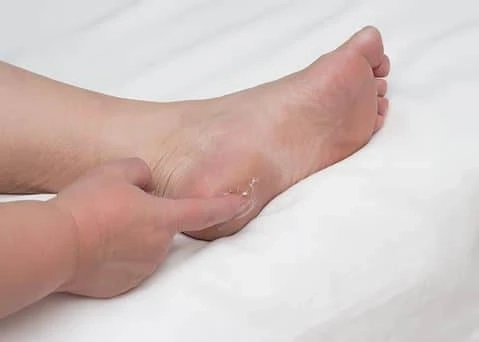A heel spur is a bony growth that develops on the underside of the heel bone. It occurs due to repeated strain or stress on the foot ligaments and muscles, leading to the pulling of the bone membrane and the formation of a spur. While heel spurs may not cause pain, they coincide with plantar fasciitis, which involves inflammation of the plantar fascia—a thick band of tissue that runs across the bottom of your foot and connects your heel bone to your toes. The combination of plantar fasciitis and a heel spur can result in heel pain when walking or standing for long periods.
Treatment for heel spurs and plantar fasciitis involves a combination of rest, ice therapy, stretching exercises, orthotic devices, supportive footwear, and sometimes corticosteroid injections to reduce inflammation. In severe cases that do not respond to conservative treatments, heel spur surgery may be considered, although it is a last resort. However, consult a podiatrist for an accurate diagnosis and personalized treatment plan tailored to your condition.
Relief from heel spurs involves a combination of self-care measures, lifestyle adjustments, and medical interventions. Here are strategies that may help alleviate heel spur discomfort:
- Rest: Reduce activities that aggravate the pain, such as prolonged standing or walking, especially on hard surfaces.
- Ice Therapy: Apply ice to the affected area for about 15-20 minutes several times a day to help reduce inflammation and numb the pain.
- Stretching: Perform gentle stretching exercises for the calf muscles and the plantar fascia to help improve flexibility and reduce tension on the heel.
- Orthotic Devices: Use supportive shoe inserts or orthotic devices to provide cushioning and support to the heel and arch of the foot, which help reduce strain on the plantar fascia.
- Proper Footwear: Wear supportive shoes with good arch support and cushioning to help distribute pressure evenly and reduce strain on the heel.
- Nonsteroidal Anti-Inflammatory Drugs (NSAIDs): Over-the-counter pain relievers like ibuprofen or naproxen help reduce pain and inflammation associated with heel spurs. However, use them according to the recommended dosage and consult with a healthcare professional if you have any concerns.
- Physical Therapy: A physical therapist provides targeted exercises, manual therapy techniques, and other modalities to help alleviate heel spur symptoms and improve foot function.
- Corticosteroid Injections: To help reduce inflammation and pain in the affected area. However, these injections are reserved for severe cases and may have potential side effects.
- Extracorporeal Shock Wave Therapy (ESWT): ESWT is a non-invasive procedure that uses shock waves to stimulate healing in the affected tissue and may help reduce pain associated with heel spurs.
- Surgery: In rare cases where conservative treatments fail to provide relief, surgery to remove the heel spur may be considered. However, surgery is usually reserved for severe cases that do not respond to other treatments.
Consult with a Houston foot doctor at DeNiel Foot and Ankle Center for an accurate diagnosis and personalized treatment plan tailored for you. They determine the appropriate course of action based on the severity of your symptoms and other factors.



